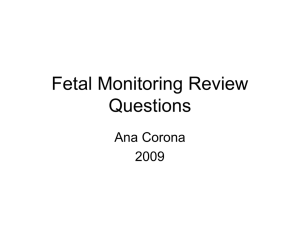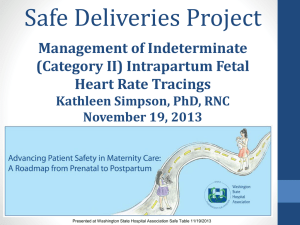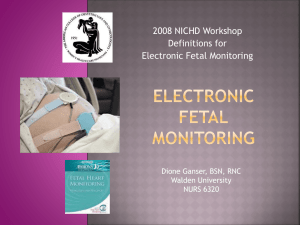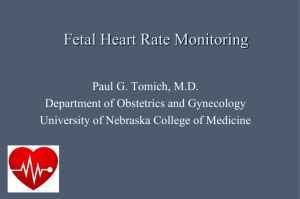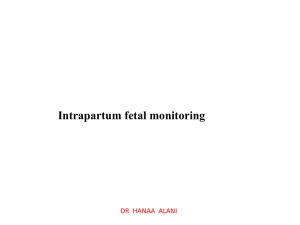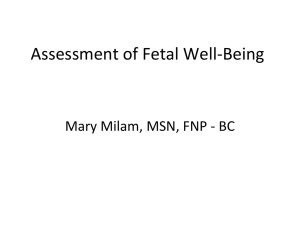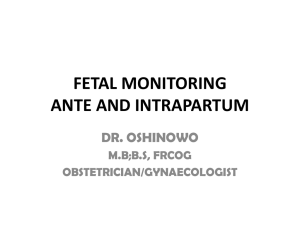pptx
advertisement
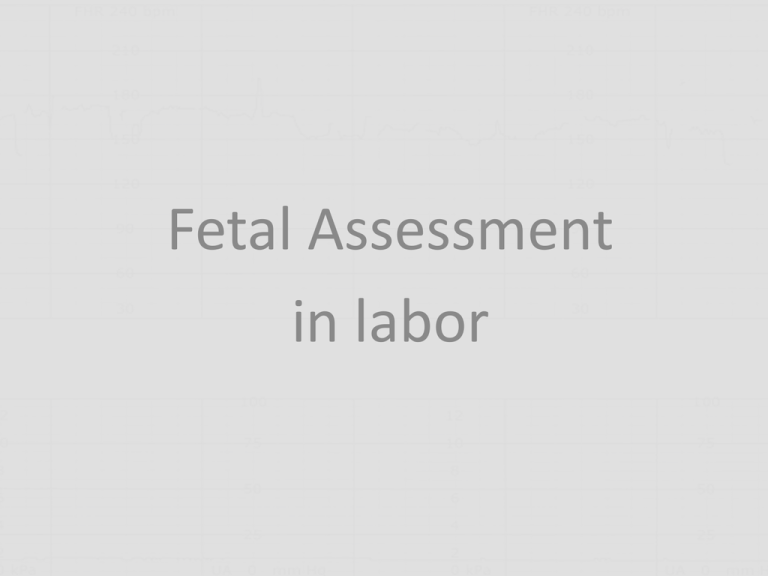
Fetal Assessment in labor Objectives • Compare fetal heart rate monitoring done by intermittent auscultation and external and internal electronic methods. • Explain baseline fetal heart rate. • Identify reassuring fetal heart rate patterns. • Describe preventative measures that can be used to maintain fetal heart rate patterns within normal limits. • Understand the concepts of timing, frequency, duration, terminology and physiology of uterine contractions. • Identify signs of non-reassuring fetal heart rate patterns, describe nursing interventions used for the management of specific fetal heart rate patterns, and discuss the etiology and rationale. During labor the fetus can be deprived of oxygen. How the infant tolerates this must be monitored. Electronic Fetal Monitoring (EFM) • External – Ultrasound transducer – Tocotransducer • Internal – Spiral electrode – Uterine catheter Fetal Heart Rate Controlled by autonomic nervous system • Sympathetic increases FHR • Parasympathetic decreases FHR Baseline fetal heart rate Average rate during 10 minute segment 110 – 160 beats per minute 130 120 Tachycardia – >160 – Early sign of fetal hypoxia – Increased maternal temperature – PPROM – drugs 190 170 150 Bradycardia – <110 – Later sign of fetal hypoxia – Decreased maternal blood pressure – Prolonged umbilical cord compression – terminal 100 80 60 FHR Baseline Characteristic Variability of FHR – Increased: early, mild sign of hypoxia and fetal stimulation – Decreased: sleep state, hypoxia, acidosis, CNS depressant medications (ominous if caused by hypoxia or associated with late decelerations) 130 120 Baseline fetal heart rate • Variability – Irregular fluctuations in FHR baseline – Rythmic wave cycles Characteristics of reassuring fetal heart rate (FHR) pattern FHR between 110-160 Normal baseline variability Absence of non-reassuring changes (decelerations) • Accelerations of FHR with Fetal movement Other Fetal Heart Rate Changes Accelerations occur spontaneously and with fetal movement and indicate fetal well-being. FHR Accelerations 15bpm 15bpm Characteristics of Normal Uterine Activity • Contractions every 2 to 5 minutes • Duration of contractions less than 90 seconds • Intensity of contractions less than 100 mm Hg pressure • 60 seconds or more from end of one contraction to beginning of another • intrauterine pressure of 15 mm Hg or less between contractions Early Decelerations Late decelerations Variable Decelerations Factors associated with reduction of fetal oxygen supply Reduction of blood flow through maternal vessels ctxs, BP, BP, hypovolemia • Reduction of oxygen content in maternal blood – Hemorrhage, severe anemia • Alteration in fetal circulation – Cord compression – transient, prolonged – Placenta separation, head compression (ICP and vagal nerve stimulation FHR • Reduction of blood flow to intervillous space in placenta – calcifications Non-reassuring fetal heart rate patterns • • • • • • • § § § § § § § Progressive or in baseline Tachycardia Decrease in baseline variability, loss of variability Severe variable decelerations Late decelerations Prolonged deceleration Severe bradycardia Nursing actions when non-reassuring FHR pattern occurs • Change mom’s position – Increase perfusion • Correct maternal hypotension – Position, fluids, drugs • Elevate hips – Increase blood return • Increase rate of IV – Increase circulating volume • Discontinue oxytocin, if infusing – Possibly give tocolytics • Administer oxygen at 10 liters minute via face mask – Firm, tight fitting face mask Non-reassuring FHR • Prepare for emergency delivery if pattern cannot be corrected Assessment of Fetal Well-being • Scalp Stimulation • Vibroacoustic • http://utilis.net/fhm/2405.htm

